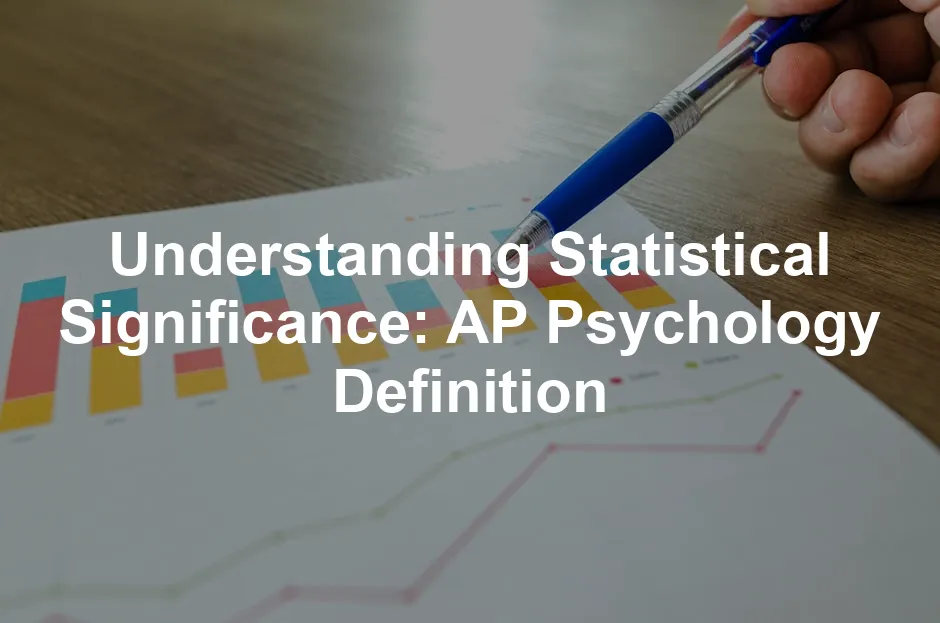Introduction
Statistical significance is a cornerstone concept in psychology. It helps researchers determine whether their findings are genuine or just random noise. Imagine you’re at a party, and someone claims their dance moves are the best. You want to know if they’re actually better or just lucky. Statistical significance provides a way to answer that question!
In the realm of psychological research, statistical significance helps researchers sift through data. It identifies whether observed differences in groups are meaningful or merely due to chance. For instance, if a study shows that a new therapy reduces anxiety, statistical significance tells us if this result is reliable or just a fluke.
Understanding statistical significance is crucial for students preparing for the AP Psychology exam. It’s not just about crunching numbers; it’s about making sense of human behavior based on solid evidence. This knowledge empowers students to interpret research findings critically and enhances their overall grasp of psychological principles.

If you’re looking to dive deeper into the world of statistics, consider picking up “Statistics for Dummies” by Deborah J. Rumsey. It’s a fantastic resource for breaking down complex concepts into bite-sized pieces, making it perfect for beginners and seasoned scholars alike!
What is Statistical Significance?
Definition of Statistical Significance
Statistical significance refers to the likelihood that the observed differences in research data are real rather than random. When researchers conduct hypothesis testing, they often use a p-value to measure this likelihood. The p-value indicates the probability that the results occurred by chance. A common threshold for significance is a p-value of 0.05. This means there’s only a 5% chance that the observed results happened randomly. If the p-value is below this threshold, researchers can confidently reject the null hypothesis.

To help with your statistical calculations, a Graphing Calculator (Texas Instruments TI-84 Plus) can be a game changer. It’s perfect for plotting your data and ensuring your results are as accurate as possible—because who wants to do math by hand, right?
Importance in Research
Statistical significance plays a pivotal role in validating research findings. It helps distinguish between genuine effects and random variations in data. Without it, researchers might mistakenly conclude that their interventions or treatments work when, in reality, they don’t. This could lead to ineffective or even harmful practices being adopted.
For example, consider a study testing a new medication. If the results show a p-value of 0.03, it suggests strong evidence that the medication has a real effect. On the other hand, a p-value of 0.08 indicates uncertainty. Therefore, statistical significance ensures that researchers can make informed decisions based on their data, ultimately leading to better psychological practices and advancements in the field.
In summary, statistical significance is not just a fancy term; it’s a vital tool for researchers. It determines whether findings are meaningful or simply products of chance. For students preparing for the AP Psychology exam, mastering this concept is essential for interpreting research and answering exam questions with confidence.

Key Concepts in Statistical Significance
P-Value
The p-value is a crucial statistical measure. It indicates the probability of observing results at least as extreme as the actual results, assuming the null hypothesis is true. A low p-value suggests strong evidence against the null hypothesis. Typically, researchers use a threshold of 0.05. If the p-value is below this threshold, researchers often reject the null hypothesis.
For instance, imagine a study testing a new medication’s effects on headache relief. If the p-value calculated from the results is 0.03, it means there’s a 3% chance the observed effects happened by random chance if the medication truly has no effect. This low p-value provides compelling evidence that the medication likely works.
Conversely, if a study finds a p-value of 0.07, researchers may feel less confident in their findings. The 7% chance of random occurrence is higher than the accepted threshold, leading to the conclusion that the results are not statistically significant.

Null Hypothesis and Alternative Hypothesis
In research, the null hypothesis (H0) serves as a starting point. It posits that no relationship exists between the variables being tested. Essentially, it claims, “Nothing is happening here.” On the other hand, the alternative hypothesis (Ha) suggests there is a significant effect or relationship.
Researchers use these hypotheses to guide their studies. For example, in a clinical trial for a new therapy, the null hypothesis might state that the therapy has no effect on patient outcomes. If the data shows statistically significant results, the researchers can reject the null hypothesis in favor of the alternative, which claims the therapy does have an effect.
This hypothesis testing framework is vital in psychological research. It allows researchers to maintain a level of skepticism and rigor, ensuring that conclusions drawn are well-supported by data rather than assumptions.

Confidence Intervals
Confidence intervals provide a range of values that likely contain the true population parameter. They reflect the uncertainty around a point estimate. For instance, a 95% confidence interval suggests that if the same study were repeated numerous times, 95% of the calculated intervals would contain the true population mean.
In psychological research, a 95% confidence interval is standard. It implies that researchers can be 95% confident the true effect lies within this interval. If a study reports that a new therapy reduces anxiety with a 95% confidence interval of [1.5, 3.5], it means the true reduction in anxiety likely falls between 1.5 and 3.5 units.
This interval approach helps contextualize results. While a p-value might indicate statistical significance, confidence intervals provide insight into the precision of the estimate. If the interval is narrow, the estimate is more precise. A broad interval suggests greater uncertainty about the true effect.
Understanding these key concepts—p-values, null and alternative hypotheses, and confidence intervals—equips students with the tools to interpret research findings critically. They are essential components of statistical significance that help researchers draw valid conclusions in the complex field of psychology.

If you want to delve deeper into the world of data analysis, consider checking out “Discovering Statistics Using IBM SPSS Statistics” by Andy Field. This book is a must-have for anyone looking to master statistical software and make sense of their data like a pro!
One-Tailed vs Two-Tailed Tests
When it comes to statistical testing, one-tailed and two-tailed tests are two important concepts. A one-tailed test examines the possibility of an effect in only one direction. For example, if researchers hypothesize that a new drug will improve symptoms compared to a placebo, they would use a one-tailed test. If the drug indeed shows improvement, the test will identify if it’s statistically significant.
In contrast, a two-tailed test looks for effects in both directions. If researchers are unsure whether the new drug might improve or worsen symptoms, they would opt for a two-tailed test. It assesses whether the drug leads to a significant difference in either direction.
Understanding the difference between these tests is crucial for interpreting results. One-tailed tests offer greater power to detect an effect in one direction, but they risk missing effects in the opposite direction. On the other hand, two-tailed tests are more conservative but provide a more comprehensive understanding of potential outcomes. Researchers must choose the appropriate test based on their hypotheses and the context of their studies.

Misinterpretations and Limitations of Statistical Significance
Common Misinterpretations
P-values often create confusion. Many believe a low p-value indicates a large or important effect. Spoiler alert: that’s not true! A p-value merely tells us about the likelihood that our results happened by chance. It doesn’t measure the size of an effect or its practical significance.
Another common misconception is that a low p-value means the null hypothesis is false. Not quite! A low p-value suggests that the observed data would be highly unlikely under the null hypothesis, but it doesn’t directly confirm its falsity. The null hypothesis could still hold true; we just have compelling evidence against it.

To further enhance your understanding, consider reading “Naked Statistics: Stripping the Dread from the Data” by Charles Wheelan. This book strips away the complexity and makes statistics accessible and enjoyable!
Limitations of Statistical Significance
Relying solely on statistical significance can lead to misleading conclusions. For one, statistical significance doesn’t guarantee the results are meaningful or applicable in real-world scenarios. For instance, a p-value below 0.05 might seem impressive, but if the effect size is tiny, the practical implications could be negligible.
Effect size is essential in research. It quantifies the magnitude of a phenomenon. Researchers should report not only p-values but also effect sizes to provide a clearer picture of their findings. This way, they ensure their results hold real-world relevance, not just statistical merit.
Moreover, practical significance matters. A statistically significant result might not translate to real-world importance. For instance, if a new teaching method improves test scores by a mere half-point, it might not justify the costs or changes needed for implementation.
In summary, while statistical significance is a valuable tool for researchers, it’s crucial to interpret it carefully. Misunderstanding p-values or ignoring effect sizes can lead to misguided conclusions. By considering both statistical and practical significance, researchers can paint a more accurate picture of their findings.

Application of Statistical Significance in AP Psychology
Real-World Examples
Statistical significance is a game changer in psychology research. It helps determine if findings are genuine or just a happy accident. For instance, consider a study examining the effectiveness of cognitive-behavioral therapy (CBT) for depression. Researchers found a p-value of 0.02, meaning there’s only a 2% chance the results occurred randomly. This strong evidence suggests CBT significantly alleviates depressive symptoms.
Another classic example involves a study on the effects of sleep deprivation on cognitive performance. Researchers discovered that participants who missed a night of sleep performed worse on memory tasks. The p-value here was 0.01, indicating a mere 1% chance that the results were due to chance. Such findings underscore the importance of sleep in maintaining cognitive function.

Understanding statistical significance not only helps students grasp these research outcomes but also aids them in tackling exam questions. Many AP Psychology exams include scenarios where students must interpret research findings. Recognizing what a significant p-value indicates can be the difference between a correct answer and a guess.
To prepare effectively, consider using a AP Psychology Exam Prep Book. It’s packed with practice questions and insights to help you ace the exam!
Preparing for the AP Exam
Studying statistical concepts for the AP Psychology exam doesn’t have to be overwhelming. Here are some effective tips to help students excel:
- Use Flashcards: Create flashcards for key terms like “p-value,” “null hypothesis,” and “statistical significance.” This method enhances recall and understanding.
- Practice with Sample Questions: Engage with practice questions from previous exams. Websites like Varsity Tutors provide excellent resources for this.
- Study Guides: Utilize comprehensive study guides tailored to AP Psychology. These guides encapsulate crucial concepts and provide examples, making complex information digestible.
- Form Study Groups: Join or form study groups to discuss statistical significance and its application in research. Explaining concepts to peers can reinforce understanding.
- Watch Review Videos: Leverage online platforms like YouTube for video explanations of statistical concepts. Visual aids can clarify difficult topics.
- Consult Your Teacher: Don’t hesitate to ask your teacher for clarification on any confusing topics. They can provide valuable insights and additional resources.

By following these tips and utilizing various resources, students can enhance their understanding of statistical significance. This knowledge will not only aid in exam success but also prepare them for future studies in psychology and related fields.
If you’re looking for a quick study boost, consider using a Flashcard Set for AP Psychology. It’s a fun way to reinforce your knowledge while on the go!

Conclusion
In summary, statistical significance is a foundational concept in psychology that enables researchers to discern genuine findings from random chance. Understanding its application is vital for students preparing for the AP Psychology exam. Recognizing p-values, the null hypothesis, and the implications of statistical tests equips students to interpret research critically.
Grasping statistical significance extends beyond exams; it fosters a deeper understanding of psychological research. Students are encouraged to apply this knowledge in their studies and future research endeavors. By doing so, they will not only excel in their academic pursuits but also contribute meaningfully to the field of psychology. So, gear up, embrace the numbers, and let statistical significance guide you through the fascinating world of psychological research!

FAQs
What is a p-value?
A p-value is a statistical measure that helps researchers determine the significance of their results. It indicates the probability that the observed differences in data occurred by chance. When researchers conduct experiments, they calculate the p-value to assess whether the results support their hypotheses. A commonly accepted threshold for significance is 0.05. If the p-value is less than this threshold, it suggests strong evidence against the null hypothesis, allowing researchers to conclude that their findings are statistically significant.
How do I know when to reject the null hypothesis?
To decide when to reject the null hypothesis, you primarily look at the p-value. If your p-value is less than or equal to the significance level (typically 0.05), you reject the null hypothesis. This means you have enough evidence to support the alternative hypothesis, which suggests a significant effect or relationship exists. Conversely, if the p-value is greater than 0.05, you fail to reject the null hypothesis, indicating insufficient evidence to support a significant finding.
What if my p-value is exactly 0.05?
When a p-value is exactly 0.05, it sits right on the threshold for statistical significance. This can be a bit of a gray area. Some researchers may interpret this as statistically significant, allowing them to reject the null hypothesis. However, others might argue for caution, suggesting that results should not be overinterpreted simply because they meet the threshold. It’s essential to consider the context of your study and whether the findings have practical relevance, regardless of this borderline p-value.
How can I improve my understanding of statistical significance?
Improving your understanding of statistical significance can be achieved through various resources. Consider joining study groups where you can discuss concepts with peers. Online platforms like Khan Academy or Coursera offer courses on statistics that cover key concepts in depth. Additionally, reading textbooks focused on statistics in psychology can provide clarity. Practice interpreting p-values and analyzing research studies to apply your knowledge effectively. Engaging with interactive tools and quizzes can also reinforce your learning.
Is statistical significance the same as practical significance?
No, statistical significance is not the same as practical significance. Statistical significance indicates that the results of a study are unlikely to have occurred by chance, typically assessed through p-values. Practical significance, on the other hand, refers to the real-world relevance or importance of the findings. For instance, a study may show statistically significant results, but if the effect size is small, it might not have meaningful implications in practice. Researchers should consider both statistical and practical significance when interpreting their results.
Understanding the difference between practical significance and statistical significance is vital for interpreting research findings. practical significance versus statistical significance
Please let us know what you think about our content by leaving a comment down below!
Thank you for reading till here 🙂
All images from Pexels




